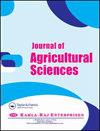Kinematics Analysis and Simulation of A 5DOF Articulated Robotic Arm Applied to Heavy Products Harvesting
IF 0.7
Q3 AGRICULTURE, MULTIDISCIPLINARY
引用次数: 18
Abstract
Robotics can play a significant role to increase efficiency and lighten the farmer’s load. Despite challenges in the agricultural robotic designs, robots are capable of performing various tasks and changing themselves accordingly, based on specific conditions. To address modern problems in the agricultural field, an agricultural robot is one of the key technologies. Although agricultural robotic is still in the development stage, robots have a bright future ahead. This paper proposes a new 5DOF articulated robotic arm design that would become a solution for heavy crop harvestings like pumpkin and cabbage. After the development stage, this robotic arm will be mounted on a robot tractor for real experimentation. The main design process of this robotic arm was conceived using 6 stages of Shigley design process. All components were designed, assembled and analyzed by using Solidworks 2014 in compliance with Japanese Industrial Standards (JIS) standards. The parts of the system that had dynamic nature were analyzed manually using standard mechanical formulas. Calculations of the workspace required joint torque, and coordination of mass center position was done by using standard machine design methods. Denavit-Hartenberg method was used to calculate forward and inverse kinematics. To resolve the torque reduction, components were designed using different materials and mass centers and comparing their performance. Results showed that total torque in Joints number 1, 2, 3, 4 and 5 were 6.15, 257.35, 103.4, 20.2 and 0.1 respectively with a rotational speed range of 15 ~ 60 rpm. Changes in the linkage material and servo motor location improved 29.7% ~ 47.7% and 29.7% ~ 68.9% of the total required torque for each joint. The maximum distance covered by the arm was 1421 mm from the and 2026 mm from the attachment point. According to the feedback received重型产品采收用五自由度机械臂运动学分析与仿真
机器人可以在提高效率和减轻农民负担方面发挥重要作用。尽管农业机器人设计面临挑战,但机器人能够执行各种任务,并根据特定条件相应地改变自己。农业机器人是解决现代农业问题的关键技术之一。虽然农业机器人还处于发展阶段,但机器人有着光明的未来。本文提出了一种新的5DOF铰接式机械臂设计,它将成为南瓜和卷心菜等重作物收获的解决方案。研发阶段结束后,该机械臂将被安装在机器人拖拉机上进行实际试验。该机械臂的主要设计过程采用了Shigley设计过程的6个阶段。所有部件均按照日本工业标准(JIS)标准使用Solidworks 2014进行设计、组装和分析。采用标准力学公式对系统中具有动态性的部分进行人工分析。利用标准的机械设计方法计算了工作空间所需的关节力矩和质心位置的协调。采用Denavit-Hartenberg方法计算正逆运动学。为解决减矩问题,采用不同的材料和质心设计了不同的部件,并对其性能进行了比较。结果表明:1、2、3、4、5号接头的总转矩分别为6.15、257.35、103.4、20.2和0.1,转速范围为15 ~ 60 rpm;连杆材料和伺服电机位置的改变分别使每个关节所需的总扭矩提高29.7% ~ 47.7%和29.7% ~ 68.9%。手臂覆盖的最大距离是1421毫米,从附着点和2026毫米。根据收到的反馈
本文章由计算机程序翻译,如有差异,请以英文原文为准。
求助全文
约1分钟内获得全文
求助全文
来源期刊

Journal of Agricultural Sciences
AGRICULTURE, MULTIDISCIPLINARY-
CiteScore
1.80
自引率
0.00%
发文量
0
 求助内容:
求助内容: 应助结果提醒方式:
应助结果提醒方式:


